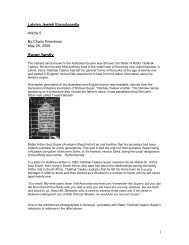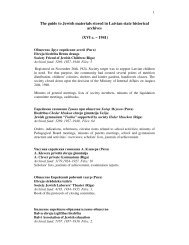Small Riga Ghetto
Small Riga Ghetto
Small Riga Ghetto
You also want an ePaper? Increase the reach of your titles
YUMPU automatically turns print PDFs into web optimized ePapers that Google loves.
130<br />
Šķirotava railroad station, but after that they were released. This was the reason<br />
why many of our doctors remained in the ghetto and the concentration<br />
camp, but unfortunately only a few of them survived.<br />
In the meantime, the prison gradually filled up with Jews who had simply<br />
been arrested on the street for various "sins" (because they were not wearing<br />
their stars, and so on). Even Jewish members of the Red Army, including<br />
high-ranking officers, were put into prison (Nowosjolok, for instance). Sick<br />
and wounded men were dragged directly from the army field hospitals into<br />
cells, where they then lay without treatment until they died. After the liquidation<br />
of the ghetto it was the turn of the "baptized" Jews (the Kalabus family<br />
and others) and those who had been living with Aryan identity papers (the<br />
lawyer A. Blankenstein and others). For a long time Blankenstein wore a crucifix<br />
in prison, but this did him no good at all. Foreign Jews with passports<br />
from Persia (Gluchowski), Brazil, Uruguay, Paraguay and the USA were also<br />
imprisoned, together with their wives and children. They too were killed.<br />
Even the aforementioned "Swedish group" (the lawyer Jewelsohn, Dr. Freidmann,<br />
F. Sacharow and others), who had tried to escape to Sweden and were<br />
betrayed at the last moment by an SD man, were put into prison. Folia Sacharow<br />
and the policeman Bruno Goldberg, who was a familiar figure in the<br />
ghetto, were separately imprisoned for a long time in a veritable cage. Later<br />
on they were killed.<br />
After the large-scale "weapons incident" in the ghetto, many people were<br />
taken to prison from the ghetto and from their place of work. These were the<br />
last and best of our young people. My comrade Dreier, who had been saved by<br />
chance, told me that after even a short time in prison he had not recognized<br />
people any more. They had long beards and could barely stand upright. Every<br />
day dysentery killed a huge number of people, but there was no help for it.<br />
At this time the prominent industrialist Niemirowski was also in prison, and<br />
he was saved by an accident. The only Jew who lay in the prison infirmary for<br />
more than a year was the mentally deranged lawyer Liebesmann. To get bread,<br />
the Jews sold their last possessions to the prison guards, and for this reason<br />
they walked about dressed only in their underwear. Everyone tried to survive<br />
by any possible means. One day it was announced that if anyone had buried<br />
valuables in the ghetto and would voluntarily surrender them, he would be released<br />
from prison. Those who volunteered were driven with Gestapo people<br />
into the ghetto to dig up the malines (hiding places). Many valuables were dug<br />
up and handed over; but this was of no use at all, for nobody was released for<br />
doing so. The only lucky one to be released was the rag merchant Dubrow, but










